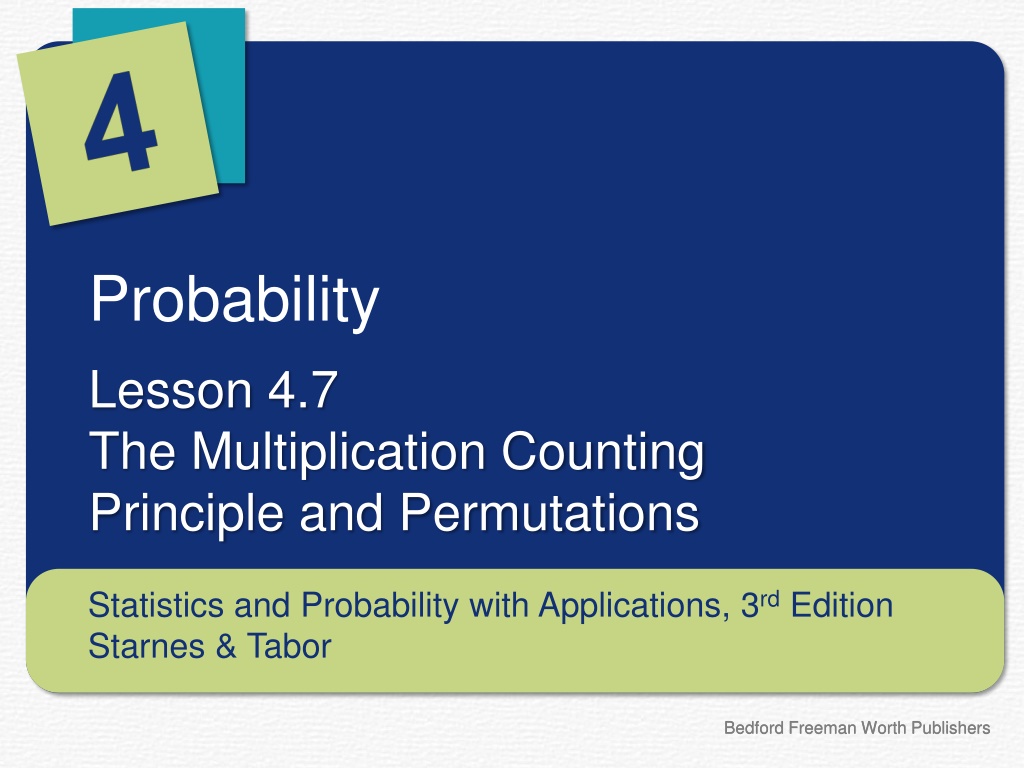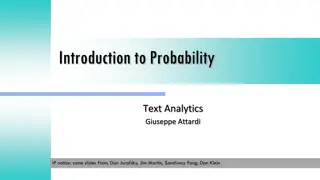The Multiplication Counting Principle in Probability: Exploring Permutations
Exploring the multiplication counting principle in probability, this lesson delves into determining the number of ways to complete a process involving multiple steps. Using factorials for permutations, the content showcases how to compute permutations of individuals taken at a time. Through examples like ordering from a restaurant menu, the essence of the principle is demonstrated vividly. Understanding this principle is crucial for grasping the fundamental concepts of permutations and probability calculations.
Download Presentation

Please find below an Image/Link to download the presentation.
The content on the website is provided AS IS for your information and personal use only. It may not be sold, licensed, or shared on other websites without obtaining consent from the author. Download presentation by click this link. If you encounter any issues during the download, it is possible that the publisher has removed the file from their server.
E N D
Presentation Transcript
Probability Lesson 4.7 The Multiplication Counting Principle and Permutations Statistics and Probability with Applications, 3rdEdition Starnes & Tabor Starnes & Tabor Statistics and Probability with Applications, 3rd Edition Bedford Freeman Worth Publishers Bedford Freeman Worth Publishers
The Multiplication Counting Principle and Permutations Learning Targets After this lesson, you should be able to: After this lesson, you should be able to: Learning Targets Use the multiplication counting principle to determine the number of ways to complete a process involving several steps. Use factorials to count the number of permutations of a group of individuals. Compute the number of permutations of n individuals taken k at a time. Statistics and Probability with Applications, 3rd Edition 2 2
The Multiplication Counting Principle and Permutations Finding the probability of an event often involves counting the number of possible outcomes of some chance process. The Agricola Restaurant offers a three-course dinner menu. Customers who order from this menu must choose one appetizer, one main dish, and one dessert. Here are the options for each course. Appetizer Main dish Dessert Butternut squash soup Grilled pork chop Chocolate cake Green salad Ribeye steak Apple and cranberry tart Caesar salad Roasted chicken breast Poached salmon How many different meals can be ordered from this menu? Statistics and Probability with Applications, 3rd Edition 3 3
The Multiplication Counting Principle and Permutations How many different meals can be ordered from this menu? We could try to list all possible orders: Soup Pork Cake, Soup Pork Tart, Soup Steak Cake, . . . It might be easier to display all of the options in a diagram: Statistics and Probability with Applications, 3rd Edition 4 4
The Multiplication Counting Principle and Permutations From the diagram, we can see that for each of the three choices of appetizer, there are four choices of main dish, and for each of those main dish choices, there are two dessert choices. So there are 3 4 2 =24 different meals that can be ordered from the three-course dinner menu. This is an example of the multiplication counting principle. Multiplication Counting Principle For a process involving multiple (k) steps, suppose that there are n1 ways to do Step 1, n2 ways to do Step 2, ..., and nk ways to do Step k. The total number of different ways to complete the process is n1 n2 nk This result is called the multiplication counting principle. Statistics and Probability with Applications, 3rd Edition 5 5
Example: Fundamental Counting Principle You are purchasing a new car. The possible manufacturers, car sizes, and colors are listed. Manufacturer: Ford, GM, Honda Car size: compact, midsize Color: white (W), red (R), black (B), green (G) How many different ways can you select one manufacturer, one car size, and one color? 6 6 6 Statistics and Probability with Applications, 3rd Edition Larson/Farber 4th ed
The Multiplication Counting Principle The Multiplication Counting Principle How many five-character passwords? Online passwords help protect confidential information. One Web site allows users to choose a password that can consist of capital letters, lowercase letters, digits, or any of 4 special symbols (#, !, %, or $). The only other requirement is that the first character of the password must be a letter. How many different five-character passwords can be created? Statistics and Probability with Applications, 3rd Edition 7 7
The Multiplication Counting Principle and Permutations The multiplication counting principle can also help us determine how many ways there are to arrange a group of people, animals, or things. We call arrangements where the order matters permutations. Permutation A permutation is a distinct arrangement of some group of individuals. Suppose you have 5 framed photographs of different family members that you want to arrange in a line on top of your dresser. In how many ways can you do this? Let s count the options moving from left to right across the dresser. There are 5 options for the first photo, 4 options for the next photo, and so on. By the multiplication counting principle, there are 5 4 3 2 1 =120 different photo arrangements. Statistics and Probability with Applications, 3rd Edition 8 8
The Multiplication Counting Principle and Permutations Expressions like 5 4 3 2 1 occur often enough in counting problems that mathematicians invented a special name and notation for them. We write 5 4 3 2 1 = 5!, read as 5 factorial. Factorial For any positive integer n, we define n! (read nfactorial ) as n! = n(n 1)(n 2) 3 2 1 That is, n factorial is the product of the numbers starting with n and going down to 1. Statistics and Probability with Applications, 3rd Edition 9 9
PERMUTATION An ordered arrangement of objects The number of different permutations of n distinct objects is n! (n factorial) n! = n (n 1) (n 2) (n 3) 3 2 1 0! = 1 Examples: 6! = 6 5 4 3 2 1 = 720 4! = 4 3 2 1 = 24 Statistics and Probability with Applications, 3rd Edition 10 10
Permutations and factorials Permutations and factorials How many finishes? At a track meet, 8 different hurdlers compete in the 400 meter hurdles. How many different ways are there for these runners to finish? Statistics and Probability with Applications, 3rd Edition 11 11
The Multiplication Counting Principle and Permutations So far, we have shown how to count the number of distinct arrangements of all the individuals in a group of people, animals, or things. Sometimes, we want to determine how many ways there are to select and arrange only some of the individuals in a group. Denoting Permutations: nPk If there are n individuals, the notation nPk represents the number of different permutations of k individuals selected from the entire group of n. You can calculate the number of permutations of n individuals taken k at a time (where k n) using the multiplication counting principle or with the formula By definition, 0! = 1. Statistics and Probability with Applications, 3rd Edition 12 12
Example: Finding nPr Find the number of ways of forming three-digit codes in which no digit is repeated. Solution: You need to select 3 digits from a group of 10 n = 10, r = 3 10! (10 3)! 10 9 8 7 6 5 4 3 2 1 7 6 5 4 3 2 1 720 ways = 10! 7! P = = 10 3 = Statistics and Probability with Applications, 3rd Edition Larson/Farber 4th ed 13 13 13
Example: Finding nPr Forty-three race cars started the 2007 Daytona 500. How many ways can the cars finish first, second, and third? Solution: You need to select 3 cars from a group of 43 n = 43, r = 3 43! (43 3)! 43 42 41 74,046 ways = 43! 40! P = = 43 3 = Statistics and Probability with Applications, 3rd Edition Larson/Farber 4th ed 14 14 14
Finding the number of permutations Finding the number of permutations What s for lunch? Your school cafeteria has purchased enough food for 12 different lunches over the next few weeks. Due to a holiday on Monday, there are only 4 school days this week. How many different ways are there for the cafeteria to select and arrange 4 of these lunches to serve? Statistics and Probability with Applications, 3rd Edition 15 15
LESSON APP 4.7 Do you scream for ice cream? The local ice cream shop in Dontrelle s town is called 21 Choices. Why? Because they offer 21 different flavors of ice cream. Dontrelle likes all but three of the flavors that 21 Choices offers: bubble gum, butter pecan, and pistachio. 1. A 21 Choices basic sundae comes in three sizes small, medium, or large and includes one flavor of ice cream and one of 12 toppings. Dontrelle has enough money for a small or medium basic sundae. How many different sundaes could Dontrelle order that include only flavors that he likes? 2. Dontrelle could order a cone with three scoops of ice cream instead of a sundae. He prefers to have three different flavors (for variety) and he considers the order of the flavors on his cone to be important. How many three-scoop cones with three different flavors that Dontrelle likes are possible at 21 Choices? Give your answer as a number and using nPk notation. Statistics and Probability with Applications, 3rd Edition 16 16
Distinguishable Permutations Consider: In how many ways can you arrange the letters in the word EATto create a new word ? In how many ways can you arrange the letters in the word MOM to create a new word ? Statistics and Probability with Applications, 3rd Edition 17 17
Distinguishable Permutations Distinguishable Permutations The number of distinguishable permutations of n objects where n1 are of one type, n2 are of another type, and so on ! ! ! ! n n n n ! n 1 2 3 k where n1 + n2 + n3+ + nk = n Use this new rule to find the number of ways to arrange the letters in the word MISSISSIPPI Statistics and Probability with Applications, 3rd Edition Larson/Farber 4th ed 18 18 18
Example: Distinguishable Permutations A building contractor is planning to develop a subdivision that consists of 6 one-story houses, 4 two-story houses, and 2 split-level houses. In how many distinguishable ways can the houses be arranged? Solution: There are 12 houses in the subdivision n = 12, n1 = 6, n2 = 4, n3 = 2 12! 6! 4! 2! 13,860 distinguishable ways = Statistics and Probability with Applications, 3rd Edition Larson/Farber 4th ed 19 19 19
The Multiplication Counting Principle and Permutations Learning Targets After this lesson, you should be able to: After this lesson, you should be able to: Learning Targets Use the multiplication counting principle to determine the number of ways to complete a process involving several steps. Use factorials to count the number of permutations of a group of individuals. Compute the number of permutations of n individuals taken k at a time. Statistics and Probability with Applications, 3rd Edition 20 20























